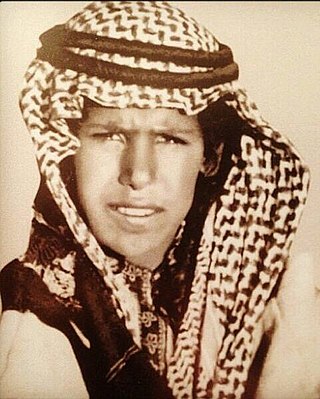
Abdulaziz bin Abdul Rahman Al Saud, known in the West as Ibn Saud, was an Arab political and religious leader who founded Saudi Arabia – the third Saudi state – and reigned as its first king from 23 September 1932 until his death in 1953. He had ruled parts of the kingdom since 1902, having previously been Emir, Sultan, and King of Nejd, and King of Hejaz.

Abdul Rahman bin Faisal Al Saud was the last emir of Nejd, reigning from 1875 to 1876 and from 1889 to 1891. He was the youngest son of Emir Faisal bin Turki bin Abdullah and the father of Abdulaziz, the founder of the Kingdom of Saudi Arabia.
Abdulaziz bin Muhammad Al Saud was the second ruler of the Emirate of Diriyah. He was the eldest son of Muhammad bin Saud and the son-in-law of Muhammad bin Abdul Wahhab. Abdulaziz ruled the Emirate from 1765 until 1803. He was nicknamed by his people as the savior of his time due to his fearless activities.
Faisal bin Turki Al Saud was the second ruler of the Second Saudi State and seventh head of the House of Saud.
Saud bin Faisal Al Saud, also known as Imam Saud, (1833—1875) was the ruler of the Second Saudi State in 1871 and 1873–75. He joined alliances with foreign tribes and revolted against his half-brother Abdullah. His rule was short-lived and Abdullah overthrew him. Saud gained power again in 1873 but died two years later. His reign was notable for the infighting in the House of Saud which he initiated.

Saud Al Kabeer bin Abdulaziz Al Saud was a grandson of Saud bin Faisal bin Turki and a distant nephew and important supporter of King Abdulaziz, founder of Saudi Arabia. Prince Saud was one of the most known Najdi people. Through his marriages he was the brother-in-law, and later he became the son-in-law, of King Abdulaziz. Saud was married for 45 years to King Abdulaziz's eldest sister Noura bint Abdul Rahman, and after her death in 1950 he married the King's daughter Princess Hessa.
Abdullah bin Jiluwi Al Saud was one of the early Saudi governors.

Sa'ad bin Abdul Rahman Al Saud (1890–1915) was the brother of Abdulaziz, Emir of Nejd. He was one of Abdulaziz's most devoted supporters and a key lieutenant in his early military campaigns.

Muhammad bin Abdul Rahman Al Saud was an Arabian soldier and politician who played a role in the conquests of his half-brother Abdulaziz that led to the formation of the Kingdom of Saudi Arabia.

Turki I bin Abdulaziz Al Saud was the eldest son of the Emir of Nejd and his second wife, Wadha bint Muhammad Al Orair. He was his father's heir apparent from 1902 to 1919. Turki accompanied his father during the conquest of the Arabian Peninsula at a young age and witnessed battles in Kuwait and Al Hasa. He died in the 1918–19 flu pandemic, which also killed many others in the region. His younger brother Saud replaced him as heir apparent.
The Battle of Jarrab was a territorial battle between the Al Saud and their traditional enemies, the Al Rashid on 24 January 1915. It was a proxy battle of World War I between the British-supported Saudis and the Ottoman-supported Rashidis.

Al-Ajman or al-'Ijman is an Arabian tribal confederation in the Arabian Peninsula, with Ajman spread across Saudi Arabia, Qatar, the United Arab Emirates and Kuwait.

Faisal bin Sultan al-Duwaish was Prince of the Mutair tribe and one of Arabia's Ikhwan leaders, who assisted Abdulaziz in the unification of Saudi Arabia. The mother of Faisal bin Sultan was from the Ajman tribe and the sister of Dhaydan bin Hithlain, another Ikhwan leader and sheikh of the Ajman tribe.
Bani Hajer, also known as al-Hawajir, are an influential tribe in the Arabian Peninsula. The tribe is also called Bani Hajer in eastern Saudi Arabia and other Arab states of the Persian Gulf.
Muhammad bin Saud Al Muqrin, also known as Ibn Saud, was the emir of Diriyah and is considered the founder of the First Saudi State and the Saud dynasty, which are named for his father, Saud bin Muhammad Al Muqrin. His reign lasted between 1727 and 1765.
Abdullah bin Faisal Al Saud was one of the rulers of the Emirate of Najd, also known as Second Saudi State. His reign witnessed extensive struggle among the members of the Al Saud family which led to turmoil in the region.
Sara bint Ahmed Al Sudairi was a Saudi royal. She was a member of the Al Sudairi family and the wife of Abdul Rahman bin Faisal who was the last ruler of the Second Saudi State. Sara was the mother of King Abdulaziz or Ibn Saud who was the founder of Saudi Arabia.

The Al-Hasa Expedition was an Ottoman military campaign to annex the El-Hasa region of eastern Arabia. Ostensibly launched to assist Imam Abdullah bin Faisal in reclaiming control over Najd from his brother Saud bin Faisal, the underlying motive was Medhat Pasha's ambition to extend Ottoman dominion over the Persian Gulf.

Dhaydan bin Hithlain was one of the leaders of the Ajman tribe and Amir of the hijrah (settlement) of Al Sarrar. His full name was Dhaydan bin Khalid bin Hizam bin Hithlain. Alexei Vassiliev also calls him Zaidan.
Fahda bint Falah Al Hithlain is the third spouse of Salman bin Abdulaziz Al Saud, the king of Saudi Arabia. She is a member of the Ajman tribe. Her mother is Munira bint Abdullah and her ancestors include Ajman tribe leaders, Rakan and Dhaydan bin Hithlain.









